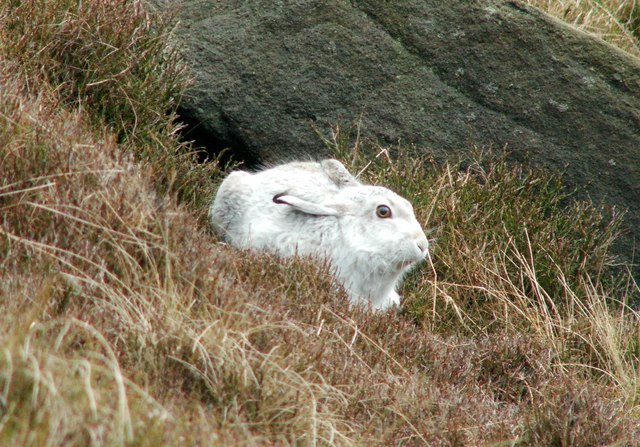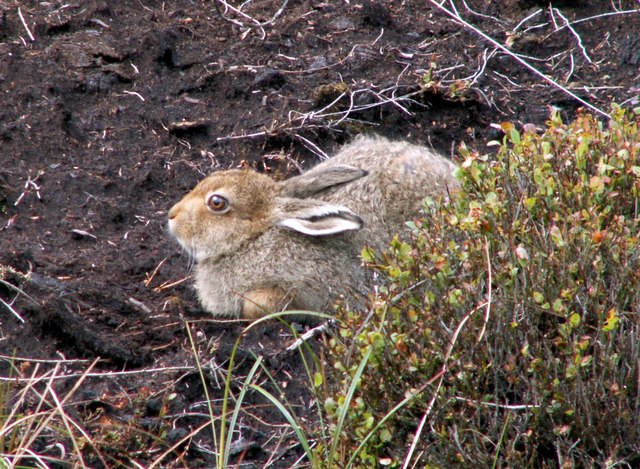The mountain hare was @SpeciesofUK from 27th
January to 2nd February 2013.
The
mountain hare, ‘Lepus timidus,’ is found from eastern Siberia to Norway. There
are isolated pockets elsewhere, including in Scotland in the UK, the Alps,
Ireland, the Baltics, Poland and, remarkably, the island of Hokkaido in Japan.
 |
| Mountain Hare, Scotland [Source: Andrew Easton] |
The mountain hare is also known as the blue hare, tundra hare,
variable hare, white hare, snow hare and alpine hare. (Just don't mix the mountain hare up with the arctic
hare! That's a native of Canada/Greenland and a different species altogether.)
Scottish names for the mountain hare include: whiddie baudrons,
bawtie, cutty, donie, fuddie, lang lugs and maukin. Gaelic names for the
mountain hare are maigheach bhan and bocaire fasaich.
The mountain hare is one of three species of Leporidae
(hares and rabbits) in the UK, and the only one that is definitely native. The other UK Leporidae are the brown hare, probably
introduced to the UK 2,000 yrs ago, and the rabbit, which was introduced to the
UK by the Romans.
In the UK, mountain hares are found in the Scottish Highlands,
some Scottish islands, the Isle of Man, Northern Ireland, and the Peak District
in England.
The
Famous Moult
The mountain hare is usually grey-blue brown, but goes through an
astonishing transformation in the winter, turning completely white.
 |
| Mountain Hare in Winter Plumage [Source: John Fielding] |
The body turns white by December, the head not until January.[1]
 |
| Mountain Hare mid-moult [Source: Dr Richard Murray] |
The white pellage of the mountain hare is brilliant camouflage in
the snow, but if the snow vanishes overnight they can be left badly exposed to
predators.
In total, mountain hares actually moult three times a year! A
"normal" moult (Jun-Sept), plus brown to white (Oct-Jan) and white to
brown (Feb-May).
Other UK species that turn white in the winter include the stoat
and the ptarmigan.
 |
| Scottish Ptarmigan in Winter [Source: Tony Kinghorn] |
Mountain hares and
Brown hares
The mountain hare is slightly smaller than its more common cousin,
the European or Brown Hare. Females are heavier than males.
The
total body length of the mountain hare is from 430 to 610 mm and the black
tipped ears from 60 to 80 mm.
The
mountain hare is easy to distinguish from the brown hare in the winter, when
the mountain hare is completely white. It's not so simple in the summer,
however, so here are some key differences between mountain hares and brown
hares when both are in their brown pellage:
1. The brown hare’s ear are famously long and would touch its nose if
pulled down, whereas the mountain hare’s wouldn’t.
2. Mountain hares have a slightly more compact shape than the lanky brown hares.
3. The mountain hare in summer has a grey/blue-ish tinge (the reason for its other name, the “blue hare”), whereas the brown hare is tawny-brown.
4. The mountain hare’s tail in summer remains completely white. The brown’s hare’s tail is part white/part black.
5. Brown hares and mountain hares’ territories hardly ever overlap! In almost all of Britain, you will only find brown hares. In the Peak District and Scottish Highlands, it’s mountain hares.[2]
 |
| Mountain Hare in Summer Coat [Source: John Fielding] |
 |
| Brown Hare showing Distinctive Black Mark on Tail [Source: Rob Burke] |
Mountain hare behaviour
In the UK, the mountain hare is mainly concentrated in Scotland,
which has around 350,000 individuals.
Here, it is only found above about
500m altitude. This range is likely to shrink due to global warming.[3]
The mountain hare has also successfully been introduced to the Peak District in England, and to the Isle of Man and the island of Mull. An introduction to Snowdonia in Wales failed.
The mountain hare has also successfully been introduced to the Peak District in England, and to the Isle of Man and the island of Mull. An introduction to Snowdonia in Wales failed.
Mountain hares are most active in the evening and at night. During
the day they are most often seen resting in sheltered scrapes with their back
to the wind. During severe blizzards, mountain hares stay put, tucked up tight,
seemingly oblivious to the weather around them.
 |
| Mountain Hare well-camouflaged [Source: TheCreator] |
In the UK, mountain hares are not seen as forest animals. In most
of their range in Scandinavia and Siberia, however, they favour boreal forests.
Mountain hares’ favourite food is young heather. They also enjoy
grasses during summer, and will even eat gorse, willow, juniper, birch and
rowan.[4]
Mountain hares are usually solitary, but can gather in groups to
feed. In spring (Feb-Apr), they can be seen in community groups more often.[5]
Mountain hare mating begins at the end of January. Females are
often seen “boxing” away several males if she is not ready to mate.[6] Mountain hare pregnancy lasts about 50 days
and the leverets are born Mar-Aug. There are 1-4 litters a year, each with 1-5
young.[7]
Mountain hares are at their most vulnerable as leverets. They are prey to foxes, stoats, birds or prey and cats.
 |
| Mountain Hare Leveret [Source: John Fielding] |
Adult mountain hares are known to live up to around nine years.
Why not indulge yourself in Scottish wildlife and watch this video of a golden eagle and mountain hares?
Peak District Hares
The only mountain hare population in mainland Britain outside
Scotland is in the Peak District in England.
 |
| Mountain Hare in the Peak District [Source: John Fielding] |
The Peak District mountain hare population was introduced for
sporting purposes in 1880. Unlike other similar introductions elsewhere this
population survived.[8]
Since the 1960s, the Peak District mountain hare numbers have been rising steadily, and now number a few thousand.
The Peak District mountain hares are usually described as an
introduced species. Strictly speaking they are Re-introduced. They were native
to the area 6,000 years ago.[9]
Tameside and Oldham Countryside Services conduct organised walks to see the Peak District’s mountain hares.[10]
Tameside and Oldham Countryside Services conduct organised walks to see the Peak District’s mountain hares.[10]
Irish Hares
In the UK, there is also a large population of mountain hares in northern Ireland. This is actually a subspecies, is found across the island of Ireland, and is also known as the Irish Hare.
The Irish Hare subspecies has been proven to be so unique and have such an ancient lineage, that some even argue it’s now a separate species from the mountain hare.[11]
The Irish hare’s coat does not change to white in the winter like the mountain hare. They are found at all altitudes, even feeding on seaweed on the beach.[12]
In the UK, there is also a large population of mountain hares in northern Ireland. This is actually a subspecies, is found across the island of Ireland, and is also known as the Irish Hare.
The Irish Hare subspecies has been proven to be so unique and have such an ancient lineage, that some even argue it’s now a separate species from the mountain hare.[11]
The Irish hare’s coat does not change to white in the winter like the mountain hare. They are found at all altitudes, even feeding on seaweed on the beach.[12]
 |
| Irish Hare [Source: AlanWolfe] |
There is some debate about whether the mountain hares on the
Scottish island of Mull are related to the Irish hares, because they also are
found on beaches eating seaweed. However, the mull hares turn white in the
winter, which is very rare among Irish Hares.[13]
Threats to the mountain
hare
Mountain hare numbers are subject to large fluctuations. They seem to reach a peak every ten years, possible related to the numbers of parasites.[14] Some suitable habitats have mountain hares in large numbers while others have none.
The BBC has a video
illustrating how warmer winters could spell tragedy for the snow-dependent
mountain hare.
A significant threat to mountain hares is excessive grazing by deer,
sheep and cattle, which depletes the heather that they need for food and cover.
Mountain hares thrive on well managed grouse moors in
central/eastern where heather is regularly burnt allowing plenty of young
shoots to appear. Mountain hares on grouse moors can reach extraordinary
densities of up to 200 individuals per sq km. Unfortunately this means they’re
seen as a competitor with grouse for food.[15]
Mountain hares also carry a tick-borne virus that kills grouse chicks. This has led to mountain hares being seen as a threat to the grouse shooting industry and snared/shot.
Mountain hares also carry a tick-borne virus that kills grouse chicks. This has led to mountain hares being seen as a threat to the grouse shooting industry and snared/shot.
One of the biggest threats to mountain hares in roadkill.
Headlights startle them badly and the hares run straight into the oncoming
vehicle. Foxes, buzzards, crows or ravens soon eat roadkill mountain hare casualties.
In parts of Scotland, mountain hares were once shot in large numbers. Englishmen came to Balmoral during Victoria’s reign to shoot them for sport.
Fortunately, in favourable conditions, the mountain hare may breed several times in a season and local populations can recover quickly.
In parts of Scotland, mountain hares were once shot in large numbers. Englishmen came to Balmoral during Victoria’s reign to shoot them for sport.
Fortunately, in favourable conditions, the mountain hare may breed several times in a season and local populations can recover quickly.
Strange but true...
Hares possess a significantly larger heart than rabbits. In hares, the heart can weigh from 1 to 1.8% of their total body weight, whereas with rabbits, the heart only weighs about 0.3% of their total body weight.[16]
[1]http://onlinelibrary.wiley.com/doi/10.1111/j.1096-3642.1958.tb00635.x/abstract
[2]http://www.merseysidebiobank.org.uk/brownhare/default.aspx?content=identification.xml
[3]http://www.hare-preservation-trust.co.uk/mountain.html)
[4]http://www.arkive.org/mountain-hare/lepus-timidus/
[6]http://www.arkive.org/mountain-hare/lepus-timidus/
[13]http://www.wildfuture.co.uk/index.php/ross-of-mull-wildlife-a-wild-places
[14]http://www.hare-preservation-trust.co.uk/mountain.html
[16]http://www.druidicdawn.org/node/1490
No comments:
Post a Comment